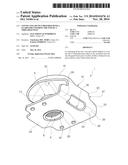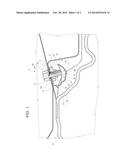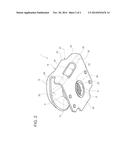Patent application title: CONNECTING DEVICE PROVIDED WITH A GUARD FOR COVERING THE END OF A THREADED STEM
Inventors:
Gianfranco Del Nero (Torino, IT)
Federico Peirone (Torino, IT)
IPC8 Class: AF16B3714FI
USPC Class:
411429
Class name: Expanded, threaded, driven, headed, tool-deformed, or locked-threaded fastener internally threaded fastener element, e.g., nut, etc. having cap
Publication date: 2014-11-20
Patent application number: 20140341676
Abstract:
A connecting device has a nut and a guard adapted to cover the end of a
threaded stem which, in use, protrudes from the nut; the guard forms part
of a plate, which is obtained in one piece and has a base which carries
the nut.Claims:
1. A connecting device (1) comprising: a nut (5) comprising a threaded
portion (9) for screwing a threaded stem (10); and a plate (18) formed in
one piece and comprising: a) a guard (16) for covering one end of said
threaded stem (10) which, in use, axially protrudes with respect to said
nut (5); b) a base (25); c) a side arm (27) joining said guard (16) to
said base (25); characterized by comprising welding means for fixing said
base (25) to a chassis portion (3), and in that said base (25) is fixed
to said nut (7).
2. The device according to claim 1, characterized in that said nut comprises a first end portion (20), which engages a hole (19) of said base (25).
3. The device according to claim 2, characterized in that said base (25) is fixed to said first end portion (20).
4. The device according to claim 3, characterized in that said base (25) is fixed by fitting said first end portion (20) by interference into said hole (19), or by upsetting said first end portion (20).
5. The device according to claim 2, characterized in that said nut (5) comprises an intermediate portion (12) having an outer diameter larger than that of said first end portion (20) so as to define an axial shoulder (24); said base (25) axially resting against said axial shoulder (24).
6. The device according to claim 5, characterized in that said nut (5) comprises a second end portion (13), which is opposite to said first end portion (20) and has an outer diameter smaller than that of said intermediate portion (12).
7. The device according to claim 1, characterized in that said base (25) is substantially flat and extends perpendicularly to the axis of said nut (5).
8. The device according to claim 1, characterized in that said plate (18) is made of metal material.
9. The device according to claim 1, characterized in that said guard (16) defines a recess (35) towards said nut (5).
10. The device according to claim 9, characterized in that said guard (16) defines a cap, which is substantially coaxial to said nut (5).
11. The device according to claim 1, characterized by comprising two curved portions (29), which are aligned along one side (28) of said base (25), join said side arm (27) to said base (25) and are separated from each other by an opening (30) along said side (28).
12. The device according to claim 1, characterized in that said side arm (27) also comprises an intermediate segment (32) and an end segment (33), which is jointed to said guard (16) and has a width which is smaller than that of said intermediate segment and is substantially equal to that of said guard (16).
Description:
[0001] The present invention relates to a connecting device provided with
a guard for covering the end of a threaded stem.
BACKGROUND OF THE INVENTION
[0002] In vehicles, the need is felt to avoid cracking or breakage of containers with liquids, in particular flammable liquids, in case of accidents, such as the fuel tank, the filter for diesel fuel, etc. . . . in order to prevent leakage of said liquids.
[0003] In particular, the fuel tanks are made of plastic material and may be damaged by the screws threads which are arranged in adjacent areas and that protrude with respect to the nut screw in which they are screwed. Therefore, it is appropriate to prevent the threads from coming into contact with the tank surface. Said need occurs, in particular, in the cars, for the screws that secure the rear seats to the chassis.
[0004] To fulfill this requirement, it is known to cover the protruding end of the screws by placing a metal guard between the outer surface of the tank and said end. The guard is shaped and dimensioned from time to time according to the spaces that are actually available and is fixed to the chassis by welding, generally after having already fixed the rear seats.
[0005] The known solutions of the type just described are hardly satisfactory since they are not always effective.
[0006] In fact, the welds that hold the guards to the chassis may fail during impacts, therefore said guards can lose their original position, and not fulfill their tank protective function.
[0007] Furthermore, guards of the known type are not standard and require relatively extended time to be fixed to the chassis.
[0008] GB1231963A describes a solution corresponding to the preamble of claim 1 and involving a tab which is folded to cover the end of a screw and is arranged between the chassis and the nut so as to remain locked as the nut is tightened. However, this solution can give rise to mounting mistakes.
SUMMARY OF THE INVENTION
[0009] Purpose of the present invention is to provide a connecting device provided with a guard for covering the end of a threaded stem, which allows to solve in a simple and economic way the drawbacks stated above.
[0010] According to the present invention a connecting device provided with a guard for covering the end of a threaded stem, as defined in claim 1 is provided.
BRIEF DESCRIPTION OF THE DRAWINGS
[0011] For a better understanding of the present invention a preferred embodiment is now described, purely by way of non-limiting example, with reference to the accompanying drawings, wherein:
[0012] FIG. 1 is a sectional view showing a vehicle tank and a preferred embodiment of the connecting device provided with a guard for covering the end of a threaded stem according to the present invention; and
[0013] FIG. 2 shows, in perspective and in enlarged scale, the connecting device of FIG. 1.
DETAILED DESCRIPTION OF THE INVENTION
[0014] In FIG. 1, the reference number 1 indicates a connecting device, which is fixed to a chassis portion 3 in an area adjacent to a tank 4 (partially shown) on a vehicle.
[0015] The connecting device 1 comprises a nut 5, made of metal material and having a hole 6, which is a through hole along an axis 7 and is coaxial with a hole 8 made in the chassis portion 3.
[0016] The hole 6 comprises a threaded portion 9 in which a threaded stem 10 is screwed, to fix a component 11 (e.g. the structure of a rear seat) to the chassis portion 3. Preferably, the nut 5 comprises an intermediate portion 12, defining the threaded portion 9 of the hole 6, and an end portion 13, which has an outer diameter smaller than that of the portion 12 and is coaxial and immediately successive with respect to the portion 12.
[0017] The threaded stem 10 passes through the hole 8 and axially protrudes from the portion 13 with its end 15, whose threads are relatively sharp and may therefore damage the tank 4 in case of an accident. To avoid said damage, the connecting device 1 comprises a guard 16 arranged in the space between the end 15 and the outer surface of the tank 4.
[0018] According to an aspect of the present invention, the guard 16 is part of a plate 18, which is defined by a single piece, distinct from the nut 5, has a hole 19 engaged by an end collar 20 of the nut 5 and is fixed to the latter.
[0019] Advantageously, the plate 18 is made of metal material and, in particular, has a constant thickness.
[0020] Preferably, the collar 20 has an outer diameter smaller than that of the portion 12 and is coaxial with respect to the immediately preceding portion 12. The nut 5 is fixed to the plate 18 by means of interference coupling on the collar 20, so that the hole 19 has an edge 23 that faces axially a shoulder 24 of the portion 12.
[0021] As an alternative to the interference coupling, the plate 18 may be fixed by riveting or upsetting, so as to plastically deform a lip or appendage of the collar 20 and clamp the edge 23 of the hole 19 in a groove between the portion 12 and the collar 20.
[0022] If she friction between the edge 23 and the outer surface of the nut 5 is not sufficient to prevent the rotation of the plate 18 about the axis 7, an additional angular retaining system may also be provided, for example a radial tooth and a corresponding seat, engaged one into the other, or a non-circular profile of the edge 23 and the outer surface of the collar 20.
[0023] With reference to FIG. 2, advantageously, the plate 18 comprises a base 25, which is substantially flat, extends perpendicularly to the axis 7, and defines the hole 19. The plate 18 also comprises a single side arm 27 arranged between the guard 16 and a side 28 of the base 25.
[0024] The arm 27 is substantially parallel to the axis and preferably is connected to the base 25 by means of two curved portions 29, which are aligned along the side 28 and are separated from each other by an opening 30 made along the side 28. The opening 30 defines a weakening adapted to favour elastic flexing and/or bending of the arm 27 with respect to the base 25.
[0025] The arm 27 also comprises an intermediate segment 32 and an end segment 33, which is connected to the guard 16 and is fixed to the portions 29 by way of the segment 32. The width of the segment 33 (measured in the direction parallel to the side 28) is smaller than that of segment 32 and is substantially equal to that of the guard 16.
[0026] With reference to FIG. 1, the guard 16 has a substantially cap or umbrella shape, with the concavity facing towards the nut 5 so as to define a recess 35 which in use accommodates the tip of the threaded stem 10. In particular, the guard 16 has a hole 36 which allows cataphoresis flow.
[0027] During assembly, after having arranged the nut 5 in a coaxial position to the hole 8 and having oriented the plate 18, so as to have the arm 27 between the nut 5 and the tank 4, the device 1 is fixed by welding the base 25 to the chassis portion 3, for example by spot welding.
[0028] The threaded stem 10 is then screwed into the nut 5 to fix the component 11: thanks to the tightening of the threaded stem 10, the device 1 remains securely locked against the chassis portion 3 (also in the case where the welding points may fail). Therefore, the welding of the base 25 to the chassis portion 3 performs only the function of maintaining the device 1 in the desired position until the tightening of the threaded stem 10.
[0029] In case of failure of the welding points between the base 25 and the chassis portion 3, after tightening the threaded stem 10 the plate 18 remains axially constrained, on one side, by the chassis portion 3 and, on the other side, by the portion 12.
[0030] In case of an accident, the plate 18 remains firmly coupled to the chassis portion 3, even when the latter is subject to deformations. In particular, the nut 5 gives an excellent locking guarantee both towards the threaded stem 10, and towards the plate 18.
[0031] At the same time, it is possible that the tank 4 and the threaded stem 10 are approaching one another, precisely because of said deformations, but the arm 27 and the guard 16 prevent the threads 15 from being in direct contact against the outer surface of the tank 4.
[0032] Furthermore, the particular shape of the arm 27 and, especially, of the guard 16 increase the guard degree of the end 15.
[0033] Therefore, it is evident how the device 1 is extremely effective to protect the tank 4. In particular, the device 1 is able to protect the tank 4 even in the presence of tests carried out according to the regulations in force (rear impact at 80 km/h).
[0034] Meanwhile, the device 1 has a relatively low number of components and can be installed in a relatively simple and fast manner on the vehicle. In fact, the nut 5 and the guard 16 are fixed one with respect to the other, so it is possible to arrange the guard 16 in the desired position relatively easily during coupling of the device 1 to the chassis portion 3.
[0035] Thanks to its construction, the device 1 is not only relatively easy to handle and mount, but also has a relatively small dimension, so it may be used practically in all cases in a standard way, i.e. without design and construction modification to the plate 18.
[0036] From the above it is, finally, evident that the device 1 described and illustrated may be subject to modifications and variants which do not depart from the scope of protection of the present invention, as defined in the appended claims.
[0037] In particular, the fixing of the device 1 to the chassis portion 3 may be absent or different from welding; and/or the plate 18 may be coupled to the nut 5 only in a provisional or labile way, instead of being fixed to the collar 20, and then remain locked in a fixed position only after having tightened the threaded stem 10.
[0038] Also, the shape of the arm 27 and/or of the guard 16 may be different from what is illustrated by way of example.
[0039] Finally, the collar 20 and the portions 12,13 may have a polygonal perimeter, rather than cylindrical; and or the portion 13 may be absent.
User Contributions:
Comment about this patent or add new information about this topic:



